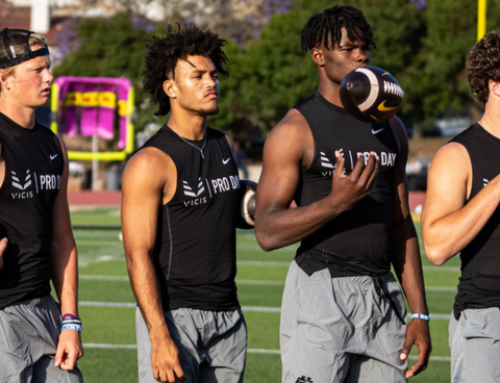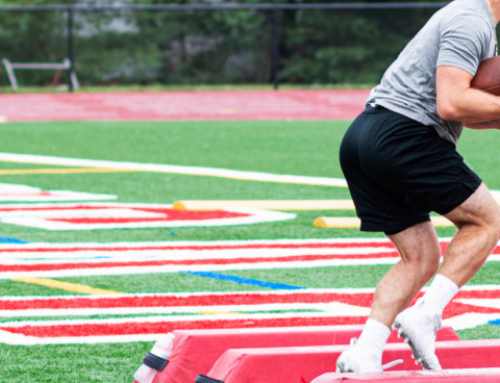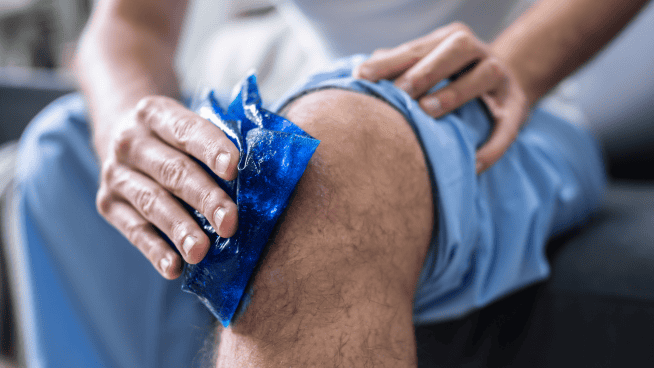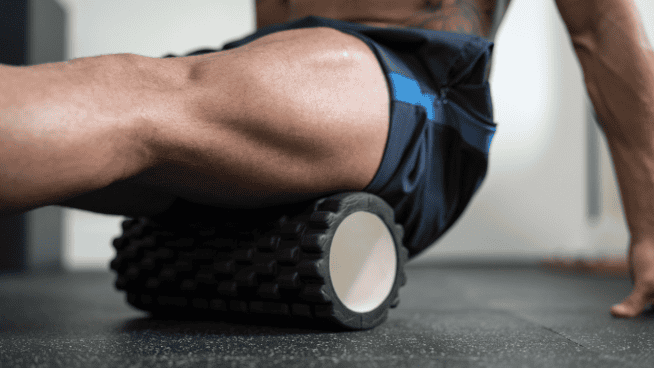Flexibility for Football
Some experts say static stretching is the best way to warm up; others have been lobbying to replace these moves with a dynamic warm-up since the 1980s, when researchers demonstrated that static stretching decreases an athlete’s power output. The research resulted in the development of performance-boosting dynamic warm-ups; but it also gave static stretching an unnecessarily bad rep.
Each prep method serves a different purpose, and one isn’t better than the other. Static stretching lengthens your muscles, which increases flexibility to stave off injuries that result from overuse, such as rotator cuff damage. Dynamic warm-ups prepare your body for high intensity work and prevent severe, immediate injuries, such as a hamstring pull.
The reality is that combining static stretching with an active warm-up reaps the most benefits. Some coaches prescribe a dynamic warm-up before training and static stretching after, but stretching post-workout doesn’t seem to produce flexibility gains. So experts recommend using both warm-up methods before a workout as the best preparation.
Use the same routine every day: foam roll, perform static stretches and finish with a dynamic warm-up.
Foam Roll
Muscles respond to injury and overuse by knotting up—becoming denser. Referred to as the “poor man’s massage,” foam rolling for five minutes decreases muscle density and is a necessary precursor to stretching.
Static Stretches
Once density is ironed out, you can work on muscle length. Soft tissue experts now recommend stretching muscles cold. They theorize that a warm muscle elongates, but then returns to its original length, whereas a cold muscle undergoes a process that may actually result in elongation long-term. I use static stretches that are easy for athletes—ones that make use of body weight and positioning.
Dynamic Warm-Up
Perform exercises like high knees, walking lunges and carioca, which prepare your body to move the way it does during training.
5 Basic Rules for Static Stretches
1. Body positioning is everything. Be aware of your posture, and use proper technique for each stretch.
2. A good stretch should be slightly uncomfortable, but not painful. Know the difference.
3. Static stretching has various forms: flexing the opposing muscle group, holding a stretch for an extended period of time and holding it briefly. Use all three techniques.
4. Perform stretches that allow your body weight to assist, such as the stretches below.
5. Focus on stretching all of your muscles, including the groin, hip flexors, lateral hamstring and hip rotators.
The following moves are designed to help athletes stretch well and correctly. Hold each one for 30 seconds, and repeat directional stretches on both sides.
Stability Ball Hamstring
• Lie on ball with legs extended up wall
Fact: The ball maintains the normal curvature of the spine, which decreases movement in the low back that compensates for tight hamstrings.
Coaching point: Touch your ankles and big toes together to loosen tight lateral hamstrings.
Stability Ball Groin (Adductor)
• Lie on ball with legs up wall
• Allow legs to fall apart into “V”
• Gravity facilitates stretch in groin
Wall Hip Rotator
• Sit on ground with back against wall and feet three to four feet in front
• Raise up on hands and feet to get butt off ground
• Cross right leg over left, then lower butt to floor
3-D Hip Flexor
You need two training tables set up a few feet apart for this stretch.
• Place elbows on table in front; place left foot on table behind you
• Sink hips to stretch hip flexor
• Slide hips side to side without raising them
• If left leg is up, reach across body with right hand for rotary stretch
RECOMMENDED FOR YOU
Flexibility for Football
Some experts say static stretching is the best way to warm up; others have been lobbying to replace these moves with a dynamic warm-up since the 1980s, when researchers demonstrated that static stretching decreases an athlete’s power output. The research resulted in the development of performance-boosting dynamic warm-ups; but it also gave static stretching an unnecessarily bad rep.
Each prep method serves a different purpose, and one isn’t better than the other. Static stretching lengthens your muscles, which increases flexibility to stave off injuries that result from overuse, such as rotator cuff damage. Dynamic warm-ups prepare your body for high intensity work and prevent severe, immediate injuries, such as a hamstring pull.
The reality is that combining static stretching with an active warm-up reaps the most benefits. Some coaches prescribe a dynamic warm-up before training and static stretching after, but stretching post-workout doesn’t seem to produce flexibility gains. So experts recommend using both warm-up methods before a workout as the best preparation.
Use the same routine every day: foam roll, perform static stretches and finish with a dynamic warm-up.
Foam Roll
Muscles respond to injury and overuse by knotting up—becoming denser. Referred to as the “poor man’s massage,” foam rolling for five minutes decreases muscle density and is a necessary precursor to stretching.
Static Stretches
Once density is ironed out, you can work on muscle length. Soft tissue experts now recommend stretching muscles cold. They theorize that a warm muscle elongates, but then returns to its original length, whereas a cold muscle undergoes a process that may actually result in elongation long-term. I use static stretches that are easy for athletes—ones that make use of body weight and positioning.
Dynamic Warm-Up
Perform exercises like high knees, walking lunges and carioca, which prepare your body to move the way it does during training.
5 Basic Rules for Static Stretches
1. Body positioning is everything. Be aware of your posture, and use proper technique for each stretch.
2. A good stretch should be slightly uncomfortable, but not painful. Know the difference.
3. Static stretching has various forms: flexing the opposing muscle group, holding a stretch for an extended period of time and holding it briefly. Use all three techniques.
4. Perform stretches that allow your body weight to assist, such as the stretches below.
5. Focus on stretching all of your muscles, including the groin, hip flexors, lateral hamstring and hip rotators.
The following moves are designed to help athletes stretch well and correctly. Hold each one for 30 seconds, and repeat directional stretches on both sides.
Stability Ball Hamstring
• Lie on ball with legs extended up wall
Fact: The ball maintains the normal curvature of the spine, which decreases movement in the low back that compensates for tight hamstrings.
Coaching point: Touch your ankles and big toes together to loosen tight lateral hamstrings.
Stability Ball Groin (Adductor)
• Lie on ball with legs up wall
• Allow legs to fall apart into “V”
• Gravity facilitates stretch in groin
Wall Hip Rotator
• Sit on ground with back against wall and feet three to four feet in front
• Raise up on hands and feet to get butt off ground
• Cross right leg over left, then lower butt to floor
3-D Hip Flexor
You need two training tables set up a few feet apart for this stretch.
• Place elbows on table in front; place left foot on table behind you
• Sink hips to stretch hip flexor
• Slide hips side to side without raising them
• If left leg is up, reach across body with right hand for rotary stretch










